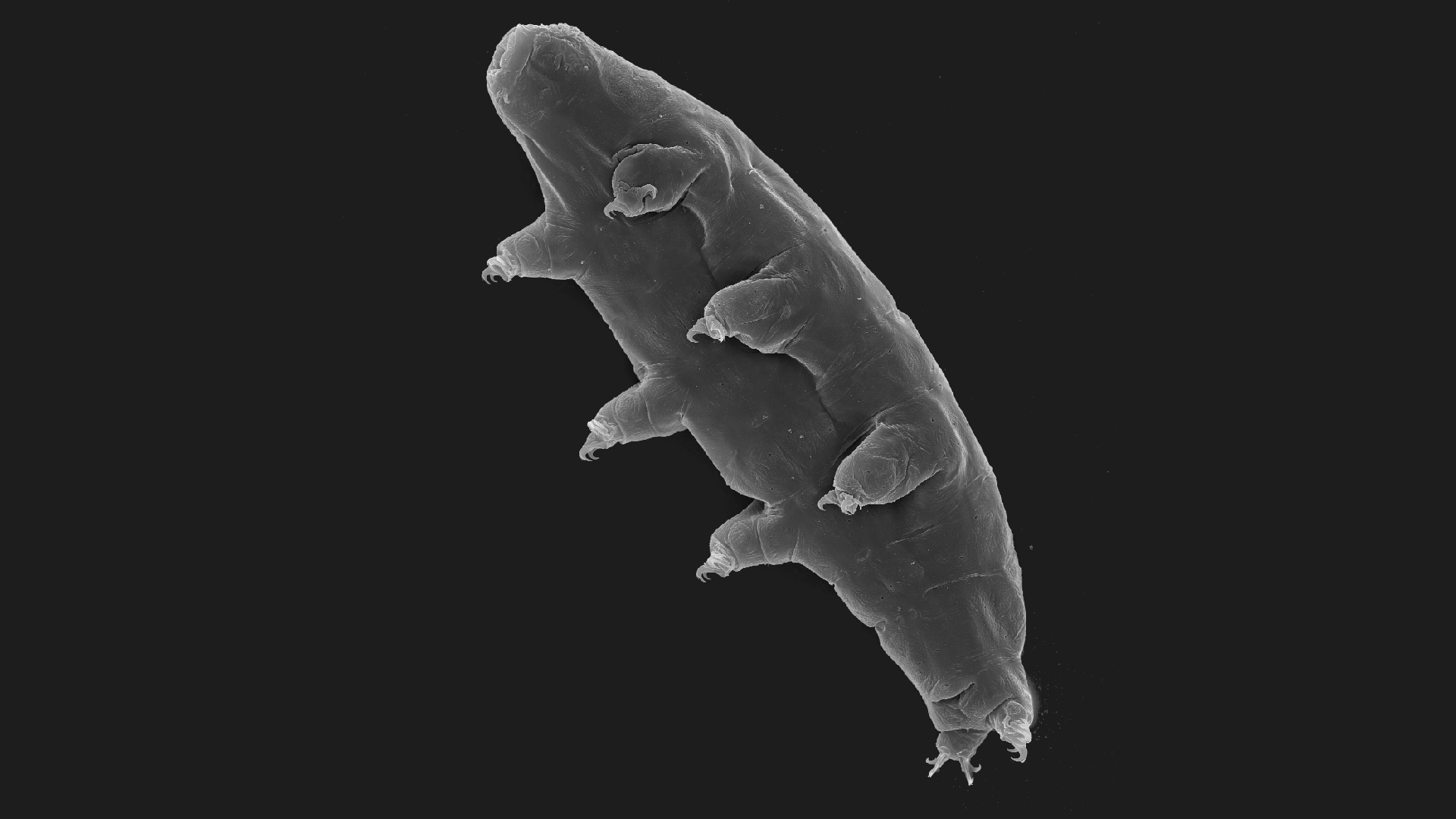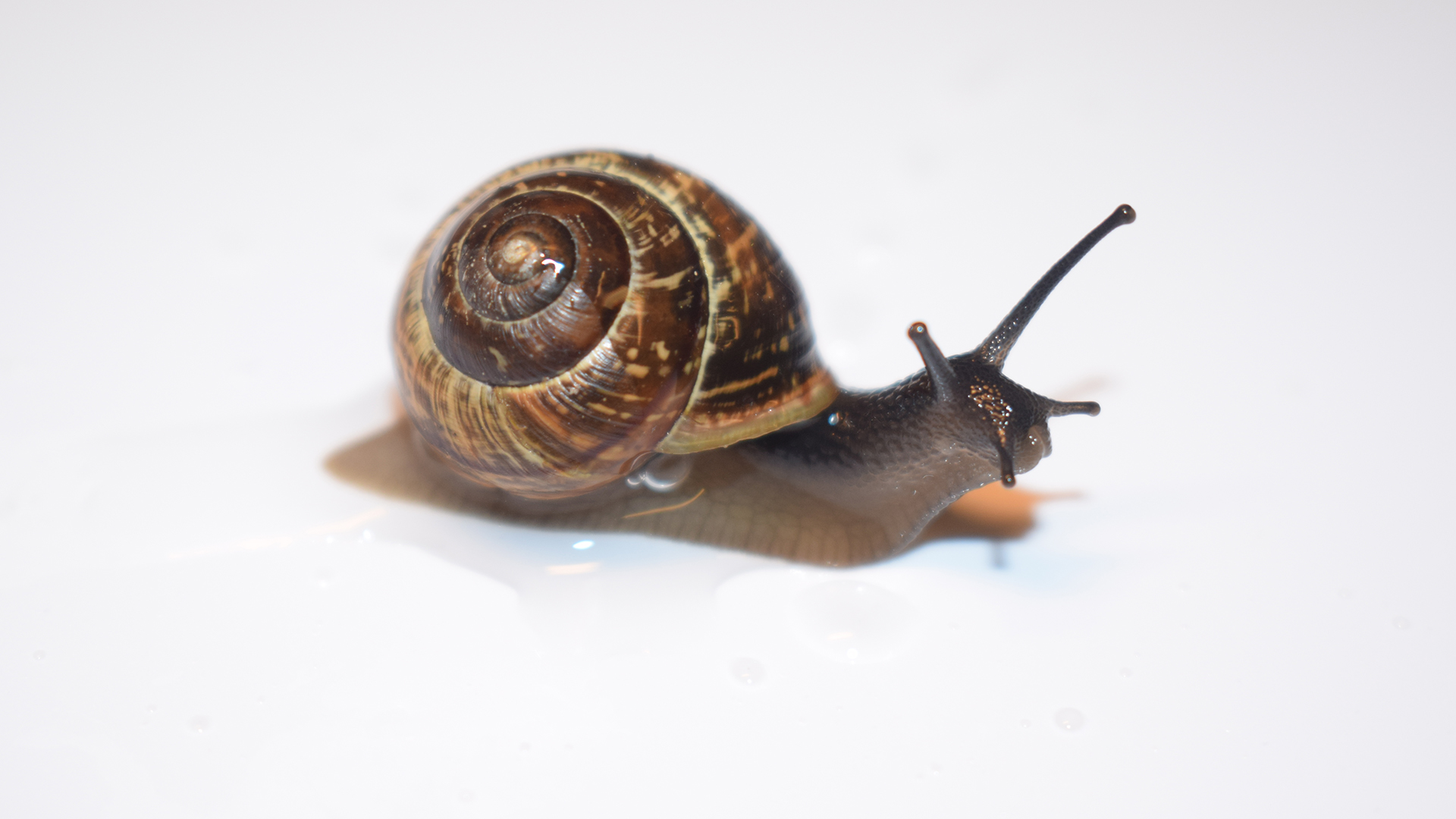Tardigrades hitch risky rides inside snail bellies, then escape in their poop
It beats walking. Sort of.

The next time you're fidgeting in an uncomfortable seat on a crowded train or airplane and wishing for a better way to travel, be grateful that you aren't a tardigrade. For these near-microscopic animals, getting from one place to another sometimes means being swallowed by a snail, riding in its guts and then exiting the mollusk via the anus, on a clump of feces.
Despite the obvious drawbacks of this arrangement, traveling by snail is certainly faster for a wee tardigrade than walking. Unfortunately, tardigrades have only about a 30% chance of surviving the trip, as they run the risk of being digested along the way, scientists discovered.
Tardigrades, also known as moss piglets or water bears, measure between 0.002 and 0.05 inches (0.05 to 1.2 millimeters) long, and are surprisingly cute for such small organisms, with endearingly tubby bodies, round faces and eight stubby legs. They are found almost everywhere on Earth where there's liquid water, but little is known about how such small creatures reach and populate new environments. Winds and water are thought to be the primary conveyors of microbial life (including tardigrades) from one ecosystem to another, and some research has suggested that larger animals may also play a role, serving as buses and taxis for microscopic stowaways.
But there was little direct evidence of tardigrade dispersal by way of snail ingestion and defecation — until now, scientists recently reported.
Related: 8 reasons why we love tardigrades
About two years ago, lead study author Tommi Vuori, a master's student in the Department of Biological and Environmental Science at the University of Jyväskylä in Finland, first considered the notion of animals swallowing and then dispersing tardigrades, he told Live Science in an email. A conversation with his supervisor about living tardigrades found in bird feces, described by researchers in 2020 in the journal Polar Biology, led Vuori to another study published in the Journal of Parasitology in 1962, in which scientists described finding live tardigrades in land snail feces.
These examples inspired him to seek other instances of tardigrade dispersal by land animals, Vuori said. He decided to look for animals that ate moss, where tardigrades are often found, and with feces that "would be easy to sample."
Get the world’s most fascinating discoveries delivered straight to your inbox.
"That's the point when copse snails (Arianta arbustorum) came to my mind," Vuori said. "Everyone who has done any gardening in Finland knows that those snails eat almost anything." So Vuori and his colleagues sampled feces from 21 copse snails collected from a community garden, brought them into the lab and spent around 30 hours examining them, finding tardigrades from two genuses — Macrobiotus and Hypsibius — in about 25% of the feces, according to the study.
"A total of 10 tardigrades were recovered from wild snail feces of which 5 were alive," the authors reported March 31 in the journal Ecology. Some of the tardigrade survivors even reproduced after their recovery, providing the first evidence of tardigrade reproduction after emerging from an animal's gut.
The researchers then fed other tardigrades to copse snails, finding that 218 of the 694 tardigrades (about 30%) survived the ordeal and were pooped out while still alive; 78 were dead on arrival, and the rest "are supposed to have been digested," the authors wrote.
Tardigrades protect themselves from potentially lethal conditions — such as temperature extremes, ultraviolet radiation, the vacuum of space, quantum entanglement and even being shot out of a high-speed gun — by entering what is known as a tun state, in which they expel moisture from their bodies and slow metabolic processes. But becoming a tun is impossible during a snail journey because the gut interior is exceptionally moist, so a traveling tardigrade would lack the protection that a tun state might offer, the scientists reported.
Most of the snails carried their water bear passengers for two days before ejecting them by process of elimination. Copse snails can travel a maximum distance of about 13 to 16 feet (4 to 5 meters) per day; that means a tardigrade traveling by a snail could relocate — and reproduce — dozens of feet from where it started, which could help wee water bears establish populations in new territories, the researchers wrote.
"Tardigrades have been previously found alive from the feces of snails and birds, but their reproductive ability after passage through the digestive system has been ignored," Vuori said in the email. Finding that tardigrades can reproduce after passing through the gastrointestinal tract of an animal — in this case, a land snail — is therefore an important discovery, and it hints at the water bears' future success in their new home, according to the study.
"Merely transporting an individual to another location is not sufficient, but reproductive ability is prerequisite for colonizing novel habitats," Vuori said.
Originally published on Live Science.

Mindy Weisberger is a science journalist and author of "Rise of the Zombie Bugs: The Surprising Science of Parasitic Mind-Control" (Hopkins Press). She formerly edited for Scholastic and was a channel editor and senior writer for Live Science. She has reported on general science, covering climate change, paleontology, biology and space. Mindy studied film at Columbia University; prior to LS, she produced, wrote and directed media for the American Museum of Natural History in NYC. Her videos about dinosaurs, astrophysics, biodiversity and evolution appear in museums and science centers worldwide, earning awards such as the CINE Golden Eagle and the Communicator Award of Excellence. Her writing has also appeared in Scientific American, The Washington Post, How It Works Magazine and CNN.



